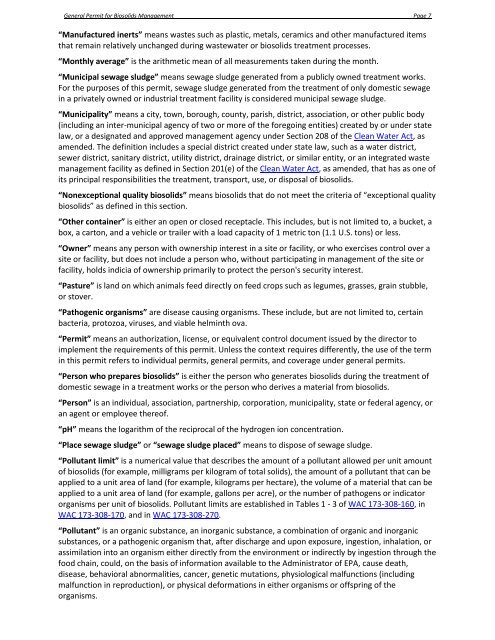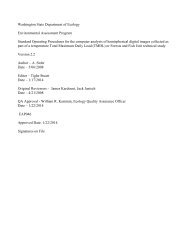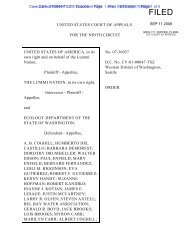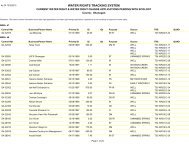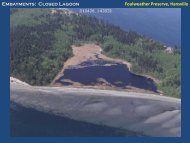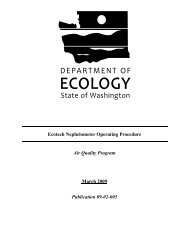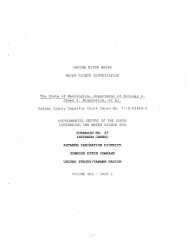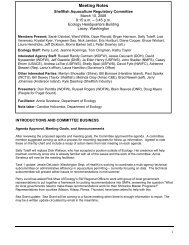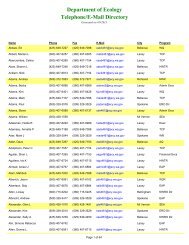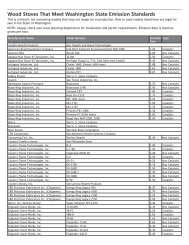General Permit for Biosolids Management - Washington State ...
General Permit for Biosolids Management - Washington State ...
General Permit for Biosolids Management - Washington State ...
You also want an ePaper? Increase the reach of your titles
YUMPU automatically turns print PDFs into web optimized ePapers that Google loves.
<strong>General</strong> <strong>Permit</strong> <strong>for</strong> <strong>Biosolids</strong> <strong>Management</strong> Page 7<br />
“Manufactured inerts” means wastes such as plastic, metals, ceramics and other manufactured items<br />
that remain relatively unchanged during wastewater or biosolids treatment processes.<br />
“Monthly average” is the arithmetic mean of all measurements taken during the month.<br />
“Municipal sewage sludge” means sewage sludge generated from a publicly owned treatment works.<br />
For the purposes of this permit, sewage sludge generated from the treatment of only domestic sewage<br />
in a privately owned or industrial treatment facility is considered municipal sewage sludge.<br />
“Municipality” means a city, town, borough, county, parish, district, association, or other public body<br />
(including an inter-municipal agency of two or more of the <strong>for</strong>egoing entities) created by or under state<br />
law, or a designated and approved management agency under Section 208 of the Clean Water Act, as<br />
amended. The definition includes a special district created under state law, such as a water district,<br />
sewer district, sanitary district, utility district, drainage district, or similar entity, or an integrated waste<br />
management facility as defined in Section 201(e) of the Clean Water Act, as amended, that has as one of<br />
its principal responsibilities the treatment, transport, use, or disposal of biosolids.<br />
“Nonexceptional quality biosolids” means biosolids that do not meet the criteria of “exceptional quality<br />
biosolids” as defined in this section.<br />
“Other container” is either an open or closed receptacle. This includes, but is not limited to, a bucket, a<br />
box, a carton, and a vehicle or trailer with a load capacity of 1 metric ton (1.1 U.S. tons) or less.<br />
“Owner” means any person with ownership interest in a site or facility, or who exercises control over a<br />
site or facility, but does not include a person who, without participating in management of the site or<br />
facility, holds indicia of ownership primarily to protect the person's security interest.<br />
“Pasture” is land on which animals feed directly on feed crops such as legumes, grasses, grain stubble,<br />
or stover.<br />
“Pathogenic organisms” are disease causing organisms. These include, but are not limited to, certain<br />
bacteria, protozoa, viruses, and viable helminth ova.<br />
“<strong>Permit</strong>” means an authorization, license, or equivalent control document issued by the director to<br />
implement the requirements of this permit. Unless the context requires differently, the use of the term<br />
in this permit refers to individual permits, general permits, and coverage under general permits.<br />
“Person who prepares biosolids” is either the person who generates biosolids during the treatment of<br />
domestic sewage in a treatment works or the person who derives a material from biosolids.<br />
“Person” is an individual, association, partnership, corporation, municipality, state or federal agency, or<br />
an agent or employee thereof.<br />
“pH” means the logarithm of the reciprocal of the hydrogen ion concentration.<br />
“Place sewage sludge” or “sewage sludge placed” means to dispose of sewage sludge.<br />
“Pollutant limit” is a numerical value that describes the amount of a pollutant allowed per unit amount<br />
of biosolids (<strong>for</strong> example, milligrams per kilogram of total solids), the amount of a pollutant that can be<br />
applied to a unit area of land (<strong>for</strong> example, kilograms per hectare), the volume of a material that can be<br />
applied to a unit area of land (<strong>for</strong> example, gallons per acre), or the number of pathogens or indicator<br />
organisms per unit of biosolids. Pollutant limits are established in Tables 1 - 3 of WAC 173-308-160, in<br />
WAC 173-308-170, and in WAC 173-308-270.<br />
“Pollutant” is an organic substance, an inorganic substance, a combination of organic and inorganic<br />
substances, or a pathogenic organism that, after discharge and upon exposure, ingestion, inhalation, or<br />
assimilation into an organism either directly from the environment or indirectly by ingestion through the<br />
food chain, could, on the basis of in<strong>for</strong>mation available to the Administrator of EPA, cause death,<br />
disease, behavioral abnormalities, cancer, genetic mutations, physiological malfunctions (including<br />
malfunction in reproduction), or physical de<strong>for</strong>mations in either organisms or offspring of the<br />
organisms.


